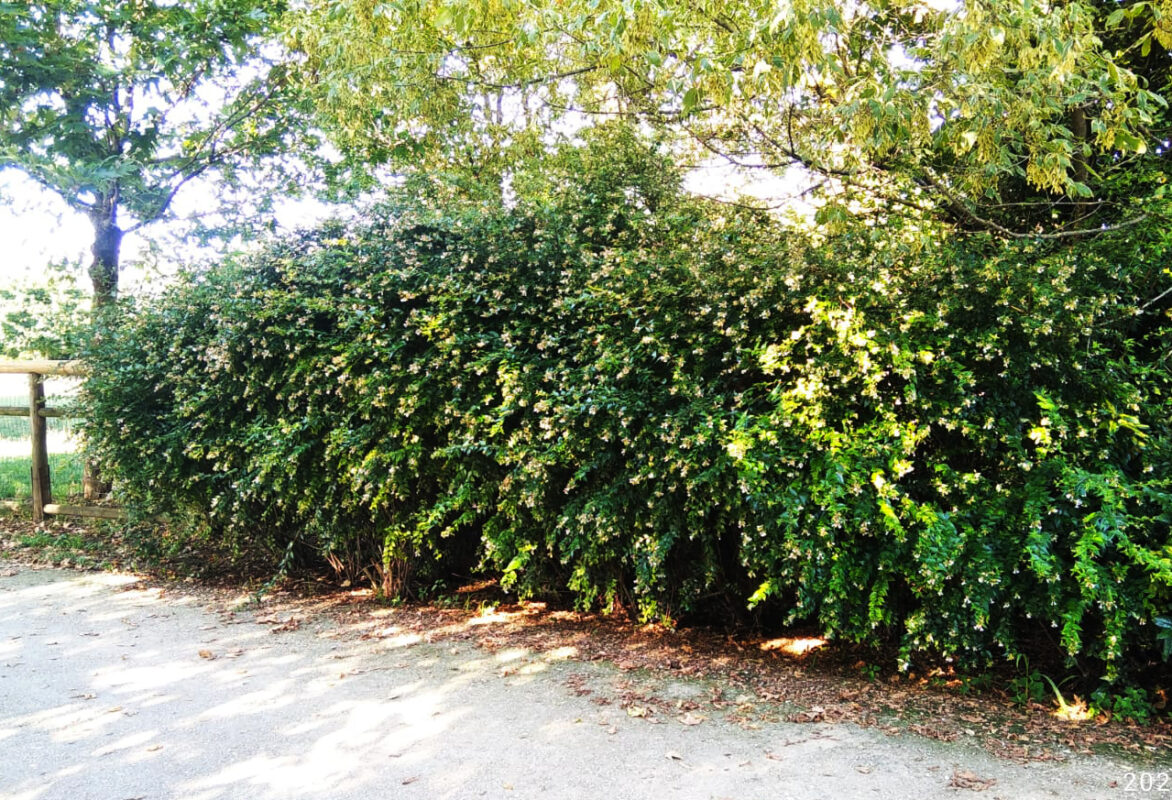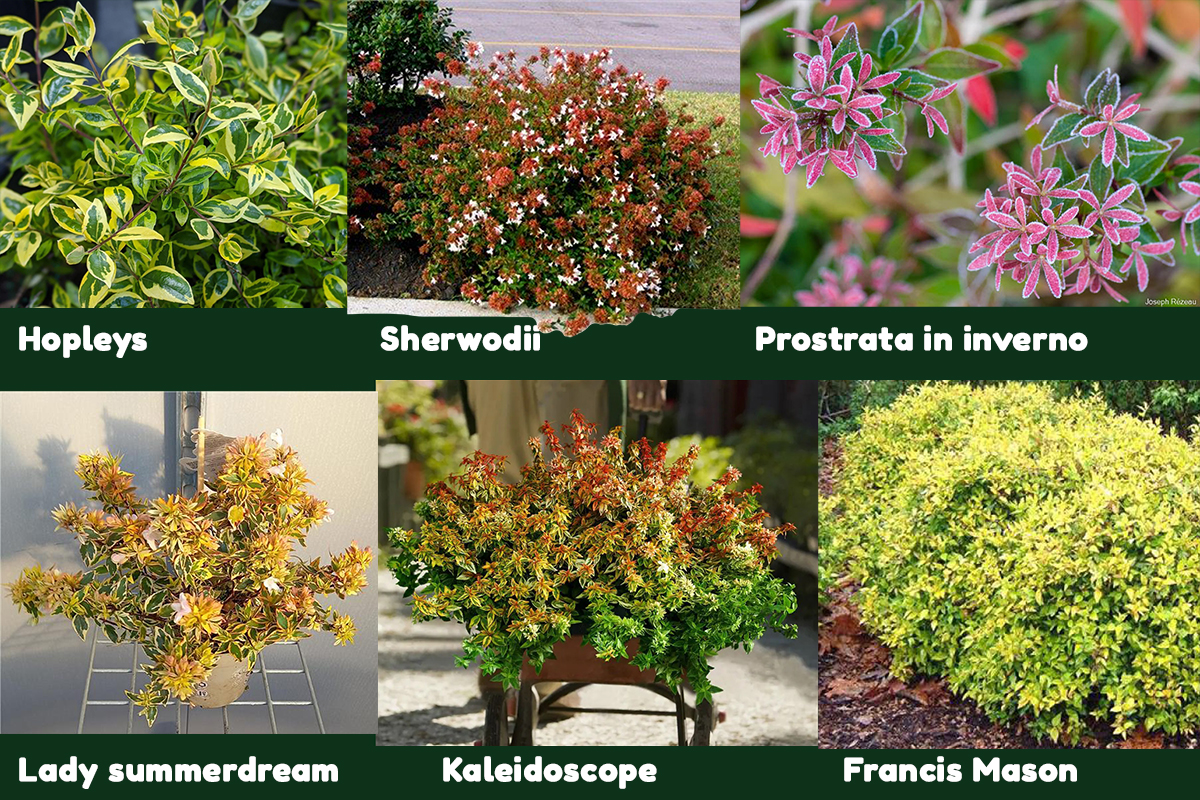IDENTIFICATION of the Abelia grandiflora
Scientific name:
Abelia grandiflora

Italian common name:
Abelia
Family:
Caprifoliaceae
Origin:
of East Asia, with the main center of diffusion in China
Enviorment:
temperate climates. It bears the cold but not the long frosts. It requires a position sheltered from the winds
Evergreen or deciduous:
Semi-evergreen
Toxicity:
not known
VEGETABLE RECOGNITION of the Abelia grandiflora
Height:
1,5 – 3 m.

Width (extension):
2 – 3 m.
Habit:
Shrub with slightly arched branches
Leaf:
small ovate, indented, bronze-colored when born, it is shiny dark green above and light green below when ripe and reddened in autumn despite being evergreen.
Flower:
small, inbutiform, pinkish white. grouped up to 4 on the branches of the year, they are often white with pink shades; the persistent sepals in late summer take on a violet colour
Flowering:
double: in spring and autumn
Fruit:
woody achene containing a single seed.
Trunk:
very dark but not visible due to the thick foliage.
Perfume:
yes

NEED
Light Exposure:
sun – partial shade
Soil type:
All
Soil acidity:
—
Italian climatic area:
Temperate climate up to -5°
Need for water:
Medium As always, it requires more watering as soon as it is planted and in a temperate climate the rains are enough. It tolerates a few days of drought. In winter, reduce but do not suspend watering because it is evergreen.
Propagation:
for seed in spring
Pruning:
practically not necessary if positioned respecting its dimensions, but in case it is needed it bears it very well.
Diseases:
Abelia fears the attack of aphids and, among the fungal diseases, it suffers from mildew especially if cultivated in regions with a very humid climate or where it rains often and abundantly.
Even if it resists the cold quite well, it still needs to be repaired at the base with a light straw mulch. And it must always be sheltered from the wind.
If the plant does not flower, it could suffer from a lack of sun and fertilizer.

PARTICULARITY
The genus Abelia Robert Brown, belonging to the Caprifoliaceae family (Linneaceae according to other classifications), is well known to enthusiasts for at least one much cultivated species. The first to arrive in Europe was Abelia chinensis, where it was introduced in 1844 by Robert Fortune but discovered by the doctor Clarke Abel from whom it takes its name; the following year Abelia uniflora arrived. Soon both were supplanted by Abelia x grandiflora, a horticultural hybrid between the two species, obtained for the first time in 1886 in the Rovelli nursery in Pallanza. It is a long-flowering, sterile semi-evergreen shrub, flowering until the first cold weather, once very popular in gardens. (and if you want to delve into this story with some very interesting true history go here
Annotations

The most interesting varieties are (height and width in brackets):
the ‘Prostrata’ which has a creeping habit (H. 40 – 60 cm x L. 1 – 1,2 m.);
the ‘Sherwoodii’ which is dwarf and compact, with smaller flowers and leaves (H. e L. 3 m.);
the ‘Edward Goucher’ which has a hanging habit, reddish young leaves and lilac-pink flowers (H. e L. 1,2 m.);
‘Kaleidoscope’, the most popular of the variegated leaves, has medium green leaves with golden yellow, orange and amber-red edges and white flowers (H. e L. 60 cm.);
the ‘Confetti’ which has a compact habit, glossy green leaves with cream edges, initially white then pinkish flowers (H. e L. 60 cm.);
‘Francis Mason’ which has golden leaves with dark green markings (H. e L. 1 – 1,8 m.);
the ‘Gold Strike’ which has golden yellow leaves (H. e L. 1,5 m.);
the ‘Lady Summerdream’ which has light green leaves edged in yellow and very long flowering (H. e L. 1,5 m.)
and ‘Hopleys’ which has yellow variegated leaves that turn dark pink in autumn (H. e L. 1,2 m.)
The abelia, in the language of flowers, symbolizes happiness and good wishes. But it is also an expression of confidence in one’s own strength and concentration in difficult moments.
Since ancient times it has been cultivated by the Chinese as a plant for ritual purposes. According to ancient beliefs, this plant has the power to protect the house and its inhabitants, including pets.
In the kitchen:
no use
THE GARDEN WORLD COUNCIL
Due to its dense foliage, Abelia grandiflora can be used in the ground or in pots to screen an area, but don’t place it too close to people because the pointed leaves are annoying.
Now on horseback! Work awaits us! Our new wonderful outdoor space is about to be born!
GOOD WORK and…if you have any questions, write to info@ilmondodelgiardino.com
Image sources: thanks to purpurea.it for the Confetti, Amazon for the Francis Mason, rezeau.com for the Prostrata in autumn and the frozen, servescape.com for the Hopleys, plantlust.com for the Sherwoodii, central-jardins.be for the Lady summerdream, donnaflora.it for the Kaleidoscope, hogendoornholland.com for the entire Fransis Mason. Thanks to Pixabay and many thanks to JackieLou DL, Mari Loli and again JackieLou DL.



